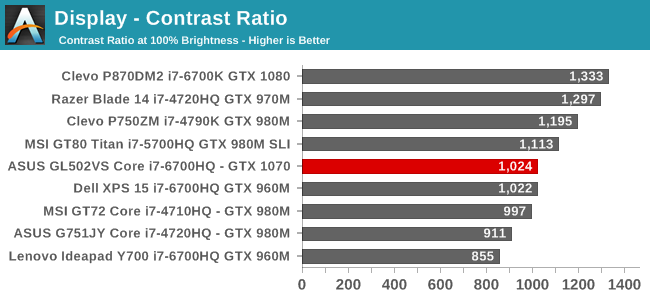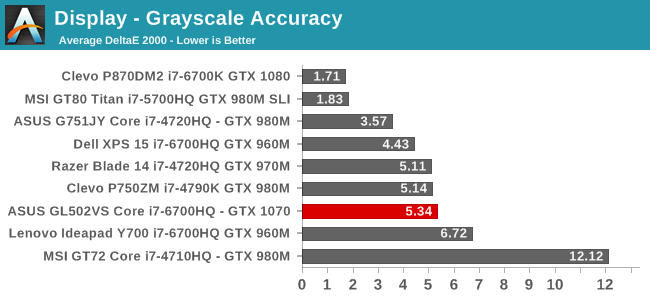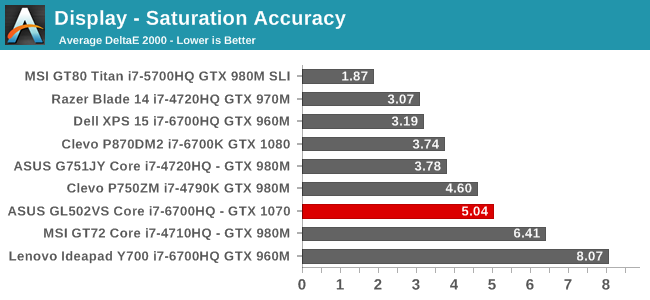The ASUS ROG Strix GL502VS Review: Mainstream GTX 1070 with G-SYNC
by Brett Howse on December 9, 2016 8:00 AM ESTDisplay
ASUS offers two displays on the 15.6-inch GL502VS. The standard model is a 1920x1080 FHD version, which is IPS and includes G-SYNC, and that is the panel in the review unit. They also offer a 3840x2160 UHD model, also with G-SYNC. Both displays are the standard 60 Hz refresh rate, but with G-SYNC available the UHD model would be a nice version to try. The display has a matte finish.
The displays cover “72% NTSC” per ASUS, but it would be nice if manufacturers would stop using NTSC as a measurement stick, since it’s not used at all in computing. 72% is sRGB though, which is the standard for computers.
To test the display accuracy, the X-Rite i1DisplayPro colorimeter is used for brightness and contrast readings, and the X-Rite i1Pro2 spectrophotometer is used for accuracy testing. On the software side, SpectraCal CalMAN 5 Business is used with a custom workflow.
Brightness and Contrast



Really high brightness values are most important in very well lit rooms, and the 344 nits output from the ASUS panel is plenty for most situations indoors. However, the black levels are a bit high, so the overall contrast ratio is about mid-pack. 1000:1 is decent for a mid-range laptop though, and it shows just how far laptops have come in the last several years. The minimum brightness is a bit of an issue though, at 38 nits, which is too bright for a very dark room, but for the average laptop on a desk, it shouldn’t be a big issue.
Grayscale Accuracy

ASUS does not do any sort of display calibration, nor do they ship with an ICC profile, so it has become a bit of an expectation to see they suffer in grayscale. The gamma is very low as well, and despite the CCT Avg being very close to ideal, it just shows how little that number means when you don’t consider all of the primary colors. The reds are far too high, and grayscale errors at 100% white are over 8, which is not ideal. It’s not the worst display around, but it is far from the best. It would be nice to see ASUS do some better calibration, even if it was per batch, to get a handle on their display errors, but they tend to value performance per dollar more, so there is always a trade-off.
Saturation Accuracy

Once again, the lack of calibration does not help the saturation results. Even at just 20% steps, it is very clear that the display is missing its targets. It does not quite cover all of the sRGB space, but it is pretty close, but the blue overshoots and the red falls a bit short. The overall score isn’t helped by the 100% white component which is over 8, but regardless the rest of the color targets have a dE2000 generally over three, and often well over.
Gretag Macbeth

The GMB score is the most comprehensive test, and focuses in on many of the skin tones. The results are not surprising, nor are they very good, with some of the orange, brown, and blue values having error levels approaching 10. The average is much better than practically any laptop from a couple of years ago, but this is a moving target and several of the vendors have focused quite a bit on display quality over the years, and it shows in their results. ASUS still does not factor this in though.
Display Conclusion
Overall the display could use some work, but in the end, it is an IPS display with G-SYNC, so for the gaming market they have the most important boxes checked. It would be great to see ASUS do some work on their displays, but at the same time this would likely add to the bill of materials for the device, possibly increasing prices, and on a value laptop like the GL502VS it is understandable to not see a calibrated display out of the box, but at the end of the day it is still well over $1000, and tablets costing far less do find room in the budget for better results here.













54 Comments
View All Comments
milkod2001 - Friday, December 9, 2016 - link
$1600 is not mainstream by all means but it has very decent specs that that price. It should last at least 3 years no probs. The only thing i would want to change is screen size, should have been 17''.Brett Howse - Sunday, December 11, 2016 - link
They do sell the GL702VM as a 17.3-inch model, but only with GTX 1060. ASUS has the GTX 1070 and up in the G752 which is a nice machine.BrokenCrayons - Friday, December 9, 2016 - link
Mainstream is different for everyone, but I agree that even on the low-end of its price spectrum that this laptop is absolutely not mainstream. However, I understand when you're a writer you're compelled to throw something out there that ultimately can end up the subject of unforseen debate. Let's try not to get overly hung up on it since, really, its as unimportant as calling a penguin a fish. The only thing that's changed is the label. Nothing fundamental about the squishy inside bits of the penguin are made different in doing so.SharpHawk - Friday, December 9, 2016 - link
No thermal data on the CPU?shelbystripes - Friday, December 9, 2016 - link
I got the GL502VM on sale from Amazon for a ridiculous $899 on Black Friday. At that price it's an utterly amazing system, and even at regular price is one of the cheapest Nvidia 10-series systems around, though I have some comments about its performance that this article fails to mention. The article makes it seem like it's just a GL502VS with a 1060 instead of a 1070, and that's not the case:1) The GL502VM doesn't come with G-Sync. At least, the lower end models don't.
2) The base model uses a quad-core i5, which is slightly slower, but more importantly lacks hyperthreading. I've found HT to historically not make a huge difference, but it's worth noting.
2) The GL502VM comes with 8GB RAM soldered on. It has one SODIMM slot, so if you buy a 16GB model it includes one 8GB DIMM plus the soldered-on RAM. Max memory capacity is limited to 24GB, since you can't swap out one channel of 8GB for 16GB later.
3) The GTX 1060 inside is the 3GB model, which actually has not just less RAM but fewer cores than the 6GB model. Still sufficient for 1080p gaming in a lot of games, especially for a budget gaming laptop, but worth noting it's about more than just the RAM. (I'm not sure if there's a similar discrepancy between the 4GB and 8GB GTX 1070 models available in the GL502VS, but at least you can get the higher end model there.)
4) This is really a comment on both machines, but the base models come with a mechanical HDD only. There's still an M.2 slot in the base models, it's just unpopulated. Still, I snagged a cheap 2.5" SATA SSD on Black Friday, and just a little simple surgery (not difficult, but 10 screws just to open it up, plus 8 screws for the HDD mount!) later, I had a MUCH faster system than I would have otherwise.
And lastly, a general tip when self-upgrading to save money: Windows 10 doesn't come with activation keys, it syncs your system unique ID to your Microsoft account. Microsoft made clean-installing Windows 10 much easier, you can download a tool from Microsoft's website to make a Windows 10 USB installer, but you'll need to boot the system at least once on the mechanical HDD to activate the copy of Windows 10 it comes with and link it to your Microsoft account. Then you can yank the HDD, swap in an SSD, and do a clean install (even if you're adding an M.2 SSD and keeping the HDD, you may want to do a clean install onto the SSD to get rid of the crapware anyway) without any problem. Just log into your Microsoft account during the reinstall and it'll recognize you have a Windows 10 license for that device. If (like me) you were clinging to Windows 7 on your last machine, I figure this knowledge might be new and useful to you.
sundragon - Friday, December 23, 2016 - link
Thank you! I may do this on my 502VS.label47 - Friday, December 9, 2016 - link
If you play heavy games the Battery will drain while plugged in...https://rog.asus.com/forum/showthread.php?88742-GL...
jsntech - Friday, December 9, 2016 - link
Yikes. Wonder what happens when it gets down to 0%? The ASUS rep responding to one of the bunches of people with the same complaint is unfortunate: " I've PM you a message, please check your inbox, thank you". Like they're trying to run interference instead of just openly acknowledging and working with customers. "Support" like that is one of the reasons I am hesitant to go with ASUS and others like them (though the bigger players are no better...sigh).kvnobrien - Friday, December 9, 2016 - link
"ASUS would have much better battery life if it just had a bigger battery" - quote of the year. Thank you this made me chuckle. I get the point you were trying to make it's just funny though.marco89nish - Friday, December 9, 2016 - link
I fail to see usefulness of G-Sync on 60Hz 1080p display with GTX 1070. It should be very challenging to drop 1070 to under 60 fps in next few years. Adding 75/90/120Hz display instead of G-Sync would yield much better value in my opinion.